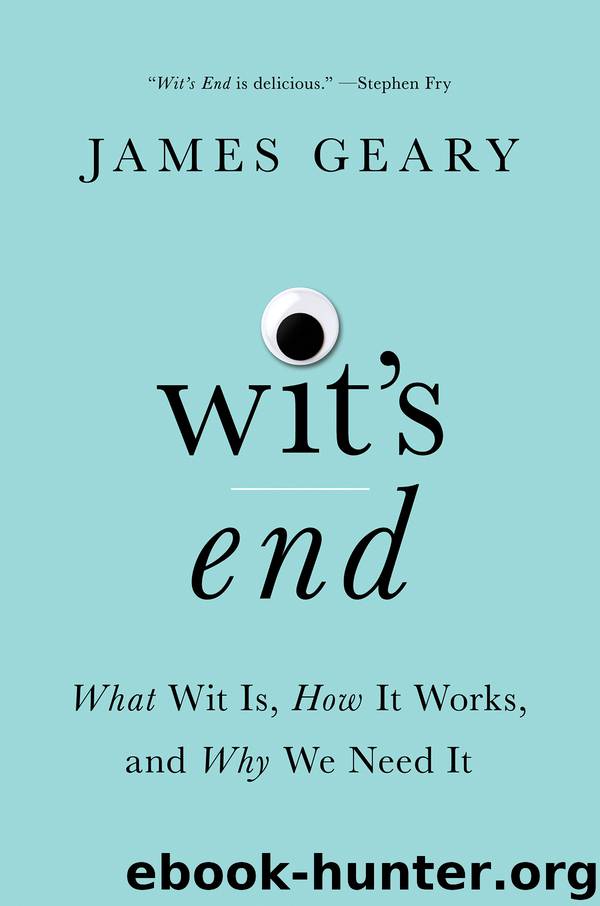Wit's End by James Geary

Author:James Geary
Language: eng
Format: epub
Publisher: W. W. Norton & Company
Published: 2018-11-01T16:00:00+00:00
THE COMPLEMENTARITY PRINCIPLE is hard for us to fathom because, in the physical world, we find it difficult to pay attention to more than one thing at a time, much less to grasp how one thing can exist simultaneously in two different states. This is evident from multiple-object tracking (MOT) experiments.
In a MOT test, participants see eight identical dots on a screen. Before the experiment begins, four dots flash to mark their status as targets. Then all the dots move randomly around the screen. The task: identify the original targets when all the dots stop.
Most people can’t keep track of more than one or two dots at once.
While multiple-object tracking may be challenging, tracking multiple meanings is easy. Indeed, this is how wit and ambiguity work together.
We have an innate ability to hold in our minds multiple meanings about the same thing at the same time. Which meaning ultimately emerges as primary depends on the experimental conditions—and, crucially, on the disposition of the observer.
There is even evidence that, when it comes to the visual arts, we prefer work that presents ambiguous interpretive challenges over work that is more straightforward and easier to interpret.
In one study, researchers showed participants photographs of ambiguous works of art—including pieces by Hans Bellmer, a German artist known for his macabre life-sized female dolls, and Magritte’s Les Jours Gigantesques, a painting in which a female nude is being assaulted, or possibly embraced, by a male figure wearing a brown jacket. Viewers rated each work according to its intellectual and emotional impact and how much they said they liked it.
The research team then showed participants photographs of the works again, this time asking them to rate each work according to its level of ambiguity and how easily they felt its meaning could be resolved. They found that the higher an artwork’s subjectively perceived ambiguity, the more participants said they liked it and the more they experienced it as both intellectually interesting and emotionally affecting.
It was the ambiguity itself that viewers found aesthetically pleasing, the researchers concluded. The more a work invited and, in some ways, resisted inquiry, the more compelling viewers tended to regard it. The process of working through the ambiguities, not the arrival at any conclusive interpretation, was what stimulated intellectual interest and emotion. This study followed earlier research by the same team that found viewers preferred simple two-tone images when they felt they could detect hidden figures within the work, again suggesting that the allure of ambiguity accounted for the pieces’ appeal.
The mind enjoys disporting itself among ambiguities.
In the Transport for London ad, as the police constable escorts Lady Smithe to the station, the detective turns to the camera and asks, “How observant were you?” in noticing the changes introduced into the proceedings. At which point the screen fades to black, and when the video resumes we see a wide-angle shot of the full set, complete with lights, cameras, actors, and technicians. The teleplay unfolds again, but this time we are eyewitnesses to how the scene of the crime is altered.
Download
This site does not store any files on its server. We only index and link to content provided by other sites. Please contact the content providers to delete copyright contents if any and email us, we'll remove relevant links or contents immediately.
| Coloring Books for Grown-Ups | Humor |
| Movies | Performing Arts |
| Pop Culture | Puzzles & Games |
| Radio | Sheet Music & Scores |
| Television | Trivia & Fun Facts |
Spell It Out by David Crystal(36021)
Professional Troublemaker by Luvvie Ajayi Jones(29571)
We're Going to Need More Wine by Gabrielle Union(18951)
The Secret History by Donna Tartt(18811)
Cat's cradle by Kurt Vonnegut(15156)
The Goal (Off-Campus #4) by Elle Kennedy(13477)
The Social Justice Warrior Handbook by Lisa De Pasquale(12126)
The Break by Marian Keyes(9289)
Crazy Rich Asians by Kevin Kwan(9147)
The remains of the day by Kazuo Ishiguro(8791)
Thirteen Reasons Why by Jay Asher(8767)
Educated by Tara Westover(7919)
The handmaid's tale by Margaret Atwood(7663)
Giovanni's Room by James Baldwin(7164)
Win Bigly by Scott Adams(7078)
This Is How You Lose Her by Junot Diaz(6761)
The Rosie Project by Graeme Simsion(6158)
Six Wakes by Mur Lafferty(6119)
The Power of Now: A Guide to Spiritual Enlightenment by Eckhart Tolle(5584)
